Лабораторные и экспериментальные исследования. Рубрика в журнале - Сибирский онкологический журнал
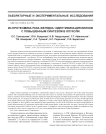
2D-протеомика рака желудка: идентификация белков с повышенным синтезом в опухоли
Статья научная
Проведен сравнительный протеомный анализ опухолевой и нормальной ткани желудка для идентификации белков, синтез которых значительно повышен в опухоли по сравнению с нормой. Использовались парные образцы опухолевой и нормальной ткани от пациентов с диагнозом рак желудка, полученные при проведении оперативного вмешательства. Для увеличения разрешающей способности 2D-гель электрофореза была использована предварительная экстракция раство- римой фракции белков для удаления мажорных структурных белков. В ходе сравнительного анализа белковых профилей опухолевой и нормальной тканей 4 пациентов с помощью MALDI-TOF масс-спектрометрии выявлено увеличение синтеза 6 белков: тропомиозина-3, тимозина бета-10, циклофилина А, катепсина Д, белка hCG1816442 и белка S100-A9. Повы- шенный уровень синтеза большинства белков подтверждается литературными данными, однако стабильное повышение уровня синтеза белка hCG1816442 в опухоли желудка обнаружено нами впервые. Для циклофилина A показан высокий уровень экспрессии только в опухолевой ткани желудка, что делает перспективными дальнейшие исследования для оценки его диагностической значимости.
Бесплатно
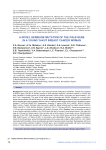
A novel germline mutation of the PALB gene in a young Yakut breast cancer woman
Статья научная
Background. Breast cancer (Bc) is the most common female malignancy worldwide. partner and localizer of BRCA2 gene ( PALB2 ) is directly involved in dNa damage response. germline mutation in PALB2 has been identified in breast cancer and familial pancreatic cancer cases, accounting for approximately 1-2% and 3-4%, respectively. the goal of this report was to describe new PALB2 mutation in a young Yakut breast cancer patient with family history of cancer. material and methods. genomic dNa were isolated from blood samples and used to prepare libraries using a capture-based target enrichment kit, Hereditary cancer solution™ (sopHia geNetics, switzerland), covering 27 genes ( ATM, APC, BARD1, BRCA1, BRCA2, BRIP1, CDH1, CHEK2, EPCAM, FAM175A, MLH1, MRE11A, MSH2, MSH6, MUTYH, NBN, PALB2, PIK3CA, PMS2, PMS2CL, PTEN, RAD50, RAD51C, RAD51D, STK11, TP53 and XRCC2 ). paired-end sequencing (2 × 150 bp) was conducted using Nextseq 500 system (illumina, usa). Results. Here we describe a case of a never-before-reported mutation in the PALB gene that led to the early onset breast cancer. We report the case of a 39-year-old breast cancer Yakut woman with a family history of pancreatic cancer. Bioinformatics analysis of the Ngs data revealed the presence of the new PALB2 gene germinal frameshift deletion (Nm_024675:exon1:c.47dela:p.K16fs). in accordance with dbpubmed clinVar, new mutation is located in codon of the PALB2 gene, where the likely pathogenic donor splice site mutation (Nm_024675.3:c.48+1delg) associated with hereditary cancer-predisposing syndrome has been earlier described. Conclusion. We found a new never-before-reported mutation in palB2 gene, which probably associated with early onset breast cancer in Yakut indigenous women with a family history of pancreatic cancer.
Бесплатно
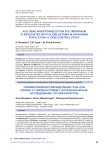
Статья научная
Background. The insertion/deletion (I/D) polymorphism of the angiotensin-converting enzyme (ACE) gene has recently been reported to be associated with the pathogenesis and development of human cancers. This study aimed to assess the potential association between ACE (I/D) polymorphism and glioblastoma in an Iranian population. Material and Methods. This case-control study was conducted on 80 patients with glioblastoma and 80 healthy blood donors as controls. Gap-polymerase chain reaction (Gap-PCR) was used to determine the ACE (I/D) genotypes. PCR products were separated and measured by electrophoresis on a 2 % agarose gel. Results. Analysis of demographic data showed a significant difference in the family history of cancer between the case and control groups (p=0.03). The distribution of ACE gene variants including II, ID, and DD genotypes was also calculated, and significant differences were seen in the DD genotype (p=0.03) and D allele (p=0.04) between the glioblastoma cases and controls. Conclusion. ACE gene polymorphism was associated with glioblastoma in the study population. Further studies are needed to approve this finding.
Бесплатно
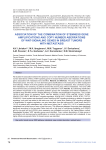
Статья научная
We studied the association between the presence of 2 or more stemness gene amplifications as well as copy number aberrations (CNAs) of WNT signaling genes in residual breast tumor and metastasis. WNT pathway genes associated with metastasis were identified. Material and Methods. The study included 30 patients with breast cancer, who had 2 or more stemness gene amplifications in the residual tumor after neoadjuvant chemotherapy. Fifteen of the thirty patients developed hematogenous metastases; they constituted a group with metastases, the remaining 15 patients entered the second group without metastases. The tumor DNA was examined using a CytoScanHD Array microarray (Affymetrix, USA). Results. By subtracting amplification and deletion frequencies in 852 cytobands between groups with metastases and without metastases, 21 cytobands were identified with the largest difference in deletion and amplification frequencies. They contain 19/150 of WNT genes (12 activators: SKP1, WNT8A, MAPK9, CCND3, FZD9, WNT8B, CCND1, PLCB2, PRKCB, FZD2, WNT3, WNT9B and 7 negative regulators: GSK3B, APC, CSNK2B, SFRP5, BTRC, TCF7L2, CSNK2A2). A point system was developed: when amplifying WNT-signaling activators or deletion of negative regulators, one point was added to the total score, and vice versa when deleting WNT-signaling activators or amplification of negative regulators, one point was taken from the total amount. it was shown that 93% (14/15) of patients with metastases had a total score higher than 0, while 93% (14/15) of patients without metastases had a total score of zero or less than zero. The differences between the groups were statistically significant according to the two-sided Fisher test with a high level of confidence probability (p=0.000003) and the log-rank test (p=0.00004) when assessing non-metastatic survival by the Kaplan-Mayer method. Conclusion Nineteen WNT signaling genes were identified. Copy number aberrations of these genes in combination with stemness gene amplifications in residual tumors were associated with metastasis. A new highly effective prognostic factor for breast cancer was identified.
Бесплатно
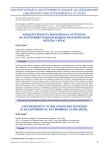
Carcinogenicity of malathion and estrogen in an experimental rat mammary gland model
Статья научная
Breast cancer is considered a major and common health problem in both developing and developed countries. The etiology of breast cancer, the most frequent malignancy diagnosed in women in the western world, has remained unidentified. Chemicals as the organophosphorous pesticide malathion have been used to control a wide range of sucking and chewing pests of field crops, and are involved in the etiology of breast cancers. The association between breast cancer initiation and prolonged exposure to estrogen suggests that this hormone may also have an etiologic role in such a process. However, the key factors behind the initiation of breast cancer remain to be elucidated. The effect of environmental substances, such as malathion and estrogen was analyzed in an experimental rat mammary gland model. Different cytoplasmic proteins are key in the transformation of a normal cell to a malignant tumor cell and among these are the Ras super family and Ras homologous A (Rho-A). both types of proteins were greater in animals treated with malathion than those with estrogens. E-Cadherins constitute a large family of cell surface proteins. results showed greater expression of E-Cadherin and vimentin than c-Ha-ras and Rho-A in rats treated by estrogens. In breast cancer, analysis using immunohistochemical markers is an essential component of routine pathological examinations, and plays an important role in the management of the disease by providing diagnostic and prognostic strategies. the aim of the present study was to identify markers that can be used as a prognostic tool for breast cancer patients.
Бесплатно
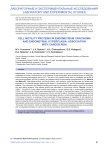
Статья научная
Introduction. Proteins associated with cellular motility are known to play an important role in invasion and metastasis of cancer, however there is no evidence of their association with the development of malignant tumors including endometrial cancer (EC). The aim of the present study was to investigate the levels of actin-binding proteins, p45-Ser-p-catenin, and calpain activity in endometrial hyperplasia and in EC. Material and Methods. Total calpain activity, p45-Ser p-catenin, Arp3, gelsolin, cofillin and thymosin p-4 levels were evaluated in 43 postmenopausal patients with stage i-ii endometrioid EC and 40 endometrial hyperplasia patients. Flow cytometry and Western blotting were used for expression determination of p45 Ser p-catenin and actin-biding proteins. Total calpain activity was estimated by fluorimetric method. Results. Levels of cofilin-1, thymosin p-4 and calpain activity were higher in cancer tissues than in endometrial hyperplasia. Cofilin-1 and thymosin p-4 levels were associated with the depth of myometrial invasion. The thymosin p-4 expression was correlated with the presence of tumor cervical invasion. Revealed correlations between the actin-binding proteins, p45-Ser-p-catenin and total calpain activity in endometrial hyperplasia tissue, but not in the tissue of cancer, is evidence of the involvement of these proteases in regulation of cell migration in endometrial hyperplasia. Levels of thymosin p-4, cofilin and total calpain activity are independent cancer risk factors in patients with endometrial hyperplasia. Conclusion. The level of actin-binding proteins as well as the total calpain activity were enhanced in endometrium carcinoma tissues compared to endometrial hyperplasia. The levels of thymosinp-4, cofilin and total calpain activity in endometrial hyperplasia tissues are associated with a hyperplasia transition to cancer and may be considered as predictive biomarkers.
Бесплатно
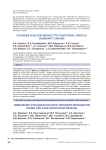
Changes in blood monocyte functional profile in breast cancer
Статья научная
The purpose of the study was to identify functional features of circulation monocytes in patients with non-metastatic breast cancer. Material and Methods. The study cohort consisted of 10 breast cancer patients treated at Tomsk Cancer Research institute. 7 healthy female volunteers were enrolled as a control group. CD14+16-, CD14+16+ and CD14-16+ monocytes subsets were obtained from blood by sorting. Whole transcriptome profiling was provided in monocytes from patients and healthy females. Macrophages were differentiated from the obtained monocytes under in vitro conditions. The ability of conditioned media obtained from macrophages to influence apoptosis and proliferation of MDA-MB 231 cell line was evaluated. Results. Transcriptomic profiling revealed significant changes in monocytes of breast cancer patients. CD14+16- subset showed higher expression of transporters ABCA1 and ABCG1; chemokines CCR1, CRRL2, CXCR4; maturation and differentiation factors Mafb and Jun; endocytosis mediating factors CD163 and Siglec1; proteases and tetrasponins ADAM9, CD151, CD82, and growth factor HBEGF in patient group. Macrophages derived from monocytes of breast cancer patients produced factors that supported proliferation of the MDA-MB 231 cell line, which was not observed for monocytes from healthy volunteers. Conclusion. Thus, breast carcinoma has a systemic effect on peripheral blood monocytes, programming them to differentiate into macrophages with tumor supporting capacity.
Бесплатно
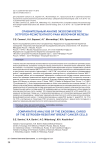
Comparative analysis of the exosomal cargo of the estrogen-resistant breast cancer cells
Статья научная
The exosomes involvement in the pathogenesis of tumors is based on their property to incorporate into the recipient cells resulting in the both genomic and epigenomic changes. Earlier we have shown that exosomes from different types of estrogen-independent breast cancer cells (MCF-7/T developed by long-term tamoxifen treatment, and MCF-7/M) developed by metformin treatment were able to transfer resistance to the parent MCF-7 cells. To elucidate the common features of the both types of resistant exosomes, the proteome and microRNA cargo of the control and both types of the resistant exosomes were analyzed. Totally, more than 400 proteins were identified in the exosome samples. Of these proteins, only two proteins, DMbT1 (Deleted in Malignant brain Tumors 1) and THbS1 (Thrombospondin-1), were commonly expressed in the both resistant exosomes (less than 5% from total DEPs) demonstrating the unique protein composition of each type of the resistant exosomes. The comparative analysis of the miRNA differentially expressed in the both MCF-7/T and MCF-7/M resistant exosomes revealed 180 up-regulated and 202 down-regulated miRNAs. Among them, 4 up-regulated and 8 down-regulated miRNAs were associated with progression of hormonal resistance of breast tumors. The bioinformatical analysis of 4 up-regulated exosomal miRNAs revealed 2 miRNAs, mir101and mir-181b, which up-regulated PI3K signaling supporting the key role of PI3K/Akt in the development of the resistant phenotype of breast cancer cells.
Бесплатно
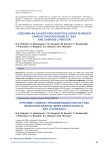
Curcumin as an anti-proliferative agent in breast cancer through RASSF1A, BAX, and CASPASE-3 protein
Статья научная
Background. Curcumin is a polyphenol that has pharmacological activity that can inhibit tumor cell growth and induce apoptosis through various mechanisms. However, the specific mechanism of curcumin cytotoxicity remains controversial because of many anti- and pro-apoptotic signaling pathways in various cell types. This study aims to examine the relationship among curcumin on RASSF1A, Bax protein levels, and caspase-3 activity in supporting the apoptotic mechanism in CSA03 breast cancer cells. Material and Methods. Curcumin administration to cancer cells is based on differences in dosage with 24-hour incubation. Cytotoxicity after curcumin administration was determined using MTS. RASSF1A and Bax protein levels were tested through ELiSA. Caspase-3 activity was used to determine apoptosis and was tested using flow cytometry. Results. The results indicated that curcumin had a cytotoxicity effect of 40.85 |jg/mL. At concentrations of 40 |jg/mL and 50 jg/mL, curcumin increases levels of protein RASSF1A (A = 26.53% and 47.35%, respectively), Bax (A = 48.79% and 386.15%), and caspase-3 (A = 1,678.51% and 1,871.889%) significantly. Conclusions. Curcumin exhibits anti-proliferative activity and apoptotic (Caspase-3) effects through activation of RASSF1A and Bax.
Бесплатно
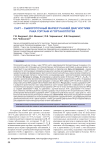
CАР1 - сывороточный маркер ранней диагностики рака гортани и гортаноглотки
Статья научная
Плоскоклеточный рак головы и шеи (ПРГШ) часто характеризуется бессимптомным течением и плохим прогнозом. Для потенциально злокачественных эпителиальных дисплазий на данный момент не существует точных критериев, способных предсказать их переход в рак. Цель исследования - оценка возможности использования определения аденилил циклаза ассоциированного протеина 1 (САР1) в сыворотке крови для формирования групп онкологического риска больных хроническими гиперпластическими процессами гортани и гортаноглотки, ассоциированными с диспластическими изменениями вэпителии. Материал и методы. Исследовалась сыворотка крови 45 больных ПРГШ (T1-4N0-3M0), 12 человек с хроническими воспалительными заболеваниями гортани и гортаноглотки (ХГЛ) и 15 здоровых волонтеров. Анализ сыворотки крови проводили с помощью ИФА набора CAP1 ELISA kit (Cusabio) на микропланшетном ИФА ридере Anthos Reader 2020 (Biochrom). Результаты. Анализ содержания САР1 всыворотке крови больных всех представленных групп показал различия в зависимости от стадии патологического процесса. Сывороточный уровень САР1 на 75 % был значимо выше у больных ПРГШ со стадией заболевания Т1N0M0 по сравнению с группой больных ХГЛ с дисплазией II-III степени. Было отмечено значимое различие в группах здоровых лиц и больных ХГЛ. В группе больных ПРГШ с регионарными метастазами содержание САР1 в сыворотке крови было выше в 2 раза (р≤0,01), чем у больных без метастазов в регионарные лимфоузлы. Заключение. Результаты исследования показали принципиальную возможность использования определения содержания САР1 для дифференциальной диагностики больных ХГЛ и раком гортани, а также для ранней диагностики ПРГШ и перспективность для разработки нового метода прогноза течения заболевания.
Бесплатно
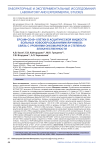
Статья научная
Цель исследования - оценить особенности взаимосвязи атипичных/гибридных форм EpCAM+CD45+ клеток в асцитической жидкости у больных новообразованиями яичников с уровнем онкомаркеров СА125, HE4 и степенью злокачественности опухоли. Материал и методы. В клиническое исследование NCT04817501 включены 48 больных с впервые диагностированными новообразованиями яичников, из которых 42 пациентки с впервые диагностированным раком яичников Ic-IV стадии по FIGO, а также 6 женщин с пограничными новообразованиями яичников (ПОЯ), в возрасте от 36 до 76 лет. Материалом для исследования служили образцы асцитической жидкости и венозной стабилизированной крови. Наличие атипичных/гибридных форм EpCAM+CD45+ клеток в асцитической жидкости определяли методом многоцветной проточной цитометрии. Уровень онкомаркеров СА125 и HE4 в сыворотке крови определяли методом ИФА. Результаты. Количество EpCAM+CD45+ клеток в асцитической жидкости больных серозной карциномой яичников составило 1,02 (0,30; 2,68) клеток/мкл, при этом в группе больных Low-grade серозной карциномы яичников (LGSC) их уровень составил 0,55 (0,03; 4,51) клеток/мкл, а в группе High-grade (HGSC) - 1,36 (0,41; 2,68) клеток/мкл. Показано, что количество EpCAM+CD45+ клеток в асцитической жидкости у больных с новообразованиями яичников имеет прямую корреляционную связь с уровнем CA125 и HE4 в сыворотке крови (R=0,60; р function show_abstract() { $('#abstract1').hide(); $('#abstract2').show(); $('#abstract_expand').hide(); }
Бесплатно
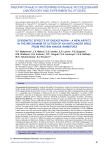
Статья научная
The purpose of the study was to analyze the ability of five antitumor drugs from the pharmaceutical group of protein kinase inhibitors (gefitinib, imatinib, pazopanib, ponatinib and enzastaurin) to reactivate the expression of the epigenetically silenced GFP in HeLa TI cells, and to estimate the effect of epigenetically active drugs on: 1) acetylation and methylation of histones H3 and H4; 2) integral DNA methylation; 3) activity of HAT and HDAC1 enzymes; 4) expression levels of the genes encoding epigenetic regulation enzymes (DNMT1, DNMT3A, DNMT3B; SIRT1, HDAC1; SETD1A, SETD1B, SUV420H1, SUV420H2, SUV39H1, SUV39H2). Material and Methods. The epigenetic activity of antitumor drugs was determined using the HeLa TI test system, a population of HeLa cells with the retroviral vector containing the epigenetically silenced GFP. The level of integral DNA methylation was analyzed using MspI/HpaII methyl-sensitive restriction analysis. Histone modifications were analyzed by Western blotting with antibodies to acetylated and methylated histones H3 and H4. The total activity of HAT enzymes was analyzed using Histone Acetyltransferase Activity Assay Kit. Expression of the epigenetic enzyme genes was analyzed using real-time quantitative RT-PCR. Results. It was shown that only the enzyme inhibitor Cp protein kinase enzastaurin had the ability to reactivate the expression of epigenetically silenced GFP in the HeLa TI cells. We showed that under the action of enzastaurin, the level of integral DNA methylation and expression of DNMT3A and DNMT3B DNA methyltransferase genes decreased. It was also found that enzastaurin reduced the expression levels of histone deacetylases HDAC1 and SIRT1, but did not affect the activity and expression levels of histone acetylases, the level of histone methylation (H3K4me3, H3K9me3, H3K27me3, H4K20me3), and the level of expression of the histone methyltransferases (SUV39H1, SUV39H2, SUV420H1, SUV420H2, SETD1A и SETD1B). Conclusion. The data obtained are important for clarifying the mechanisms of action of 5 protein kinase inhibitors, in particular with respect to enzastaurin, the protein kinase Cp inhibitor, for which the ability to reactivate epigenetically silent genes due to the effect on DNA methylation and histone acetylation was demonstrated.
Бесплатно
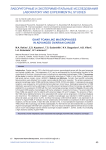
Giant foam-like macrophages in advanced ovarian cancer
Статья научная
Introduction. Ovarian cancer (OC) is the third most common gynecological cancer with the worst prognosis and highest mortality rate. The progression of OC can be accompanied by the detrimental functions of the components of the tumor microenvironment, including tumor-associated macrophages (TAMs). The purpose of the study to analyze distribution and morphological phenotype of TAMs in tumor tissue of patients with high-grade serous ovarian cancer (HGSOC). Material and Methods. Formalin fixed paraffin embedded tissue sections were obtained from ovarian cancer patients after tumor resection. The protein expression of general macrophage marker CD68 and M2-like markers CD206, CD163 and stabilin-1, belonging to scavenger receptors, was analysed by immunohistochemical staining in tumor tissue. Histological assessment of TAM distribution was performed by pathologist. Immunofluorescent analysis/confocal microscopy was applied to establish the co-expression of CD68 with the main macrophage scavenger receptors. Results. We were able to find giant CD68-positive macrophages with foamy cytoplasm in ovarian tumor tissue. The accumulation of these TAMs was specific only for patients with advanced stage (IIIC and IV stages). The presence of foam-like TAMs had a statistical tendency to be associated with ovarian cancer progression, including metastasis and recurrence. The distribution of stabilin-1-positive macrophages was matched to CD68 expression in almost all cases, as was shown by IHC. Confocal microscopy confirmed that stabilin-1 was expressed in at least 50 % of giant TAMs. IF analysis of tumor samples also demonstrated co-expression of other scavenger receptors, CD163 and CD36, in foam-like cells. Similar to IHC, in most samples the expression of CD206 in TAMs of foam-like morphology was limited. Conclusion. For the first time we demonstrated the accumulation of giant macrophages with fluffy foam cytoplasm in the tumor tissue of treated patients with advanced ovarian cancer. Such macrophages express diverse scavenger receptors (stabilin-1, CD163, CD36), thus indicating a high clearance activity of giant TAMs.
Бесплатно
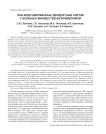
IFN-индуцированные дендритные клетки у больных множественной миеломой
Статья научная
Проведено сравнительное исследование фенотипических и функциональных свойств дендритных клеток (ДК), генери- рованных in vitro в присутствии GM-CSF и IFN-α, у здоровых доноров (n=34) и больных множественной миеломой (n=12). Показано, что по своему составу (количеству зрелых/незрелых ДК и клеток промежуточной степени зрелости) популяция ДК больных в целом была сопоставима с ДК здоровых доноров. ДК больных множественной миеломой (ММ) не отличались от ДК доноров по уровню продукции IFN-γ и TNF-α. В то же время ДК больных характеризовались более низким содержанием активированных CD25+клеток в сочетании с повышенной продукцией IL-10, что, по-видимому, обусловливало ослабление их стимуляторной активности в СКЛ. Тем не менее ДК больных ММ сохраняли свою способность к запуску Th1-ответа, что проявлялось 5-кратным увеличением количества CD3+IFN-γ+ Т-клеток. Полученные данные аргументируют возмож- ность клинического применения ДК у больных ММ в качестве клеточных вакцин (особенно в сочетании с адъювантной цитокинотерапией) с целью повышения эффективности противоопухолевого иммунного ответа.
Бесплатно
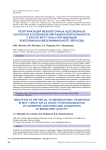
Статья научная
Using DIC and confocal microscopy, changes in morphology, migratory characteristics and adherence junctions (AJs) were analyzed in the mammary carcinoma cell line MCF-7-SNAI1 after activation of the EMT transcription factor SNAI1. Western blot analysis showed that after removal of tetracycline from the cell culture medium expression of SNAI1 reached its peak in 24 hours and then plateaued for 7 days. During the 7 days the cells continued to express E-cadherin; however, tangentialAJs typical for cells with stable cell-cell adhesion, changed into radial AJs. The radial AJs continued to accumulate E-cadherin during 24-72 hours after tetracycline removal. As a result of SNAI1 activation, the cells underwent epithelial-mesenchymal transition (EMT) and became migratory. On a two-dimensional substrate, cells exhibited both individual and collective migration. As the tetracycline washout period progressed, the fraction of the cells capable of migrating through migration chamber membranes increased; on the contrary, cells’ ability to invade an epithelial monolayer decreased. These results demonstrate that retaining a hybrid epithelial/mesenchymal phenotype and accumulation of E-cadherin in AJs during early stages of EMT do not impede disruption of stable cell-cell adhesion and cells’ acquisition of migratory activity.
Бесплатно
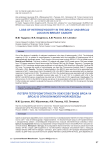
Loss of heterozygosity in the BRCA1 and BRCA2 locus in breast cancer
Статья научная
One of the factors of variability of malignant neoplasms is the loss of heterozygosity (LOH). The biological meaning of LOH, in relation to carcinogenesis, is associated with the inactivation of heterozygous loci of pathogenetically significant genes. Thus, the aim of this work was to study BRCA1/2 LOH in breast tumors. Material and Methods. The study included 122 patients with stage IIAIIIC breast cancer. DNA was isolated from 122 biopsy samples of tumor tissue using the QIAamp DNA mini Kit (Qiagen, Germany). To assess the status of LOH, microarray analysis was performed on high-density DNA chips from Affymetrix CytoScanTM HD Array. To process the results of microchipping, we used the Chromosome Analysis Suite 3.3 program (Affymetrix, USA). Results. The loss of heterozygosity in the BRCA1 gene was found to be associated with response to NAC. It was shown that in 59 patients LOH in the BRCA1gene was associated with an objective response to treatment (p=0.005). The presence of LOH in the studied genes was associated with a favorable prognosis. The 5-year non-metastatic survival rates were 75 % and 100 % in patients with LOH in the BRCA1 and BRCA2 genes, respectively (log-rank test: p=0.003 and p=0.05, respectively). Conclusion. The phenomenon of LOH in the BRCA1/2 genes was shown to be associated with response to NACT. BRCA1/2. Further studies are needed to evaluate the frequency of BRCA1/2 LOH after NAC for choosing and changing treatment tactics.
Бесплатно
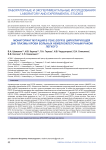
Статья научная
Activating mutations of egfr are associated with sensitivity of non-small cell lung cancer (NSCLC) to tyrosine kinase inhibitors (TKI). Liquid biopsy using circulating cell-free tumor DNA (cfDNA) is proposed in cases when formalin fixed paraffin embedded (FFPE) tumor tissue is not available and for monitoring of egfr status. In the study we evaluated new qPCR assay for egfr mutations in plasma cfDNA. Sensitivity of the assay was 1 % of the mutant allele for L858R, L861Q, S768I mutations and deletions in exon 19, and 5 % of the mutant allele for G719X or T790M mutations Before surgery, mutation was detected in plasma of 4 out of 7 patients (57 %) with mutant egfr in FFPE tumor tissue. Mutations found in cfDNA completely matched those found in tumor tissue in 2 cases. In one case with G719X and S768I mutations in FFPE tissue, only S768I was found in cfDNA. In another case, T790M was detected in plasma in addition to L858R that was present in tumor tissue. No egfr mutations were detected in plasma DNA from 12 healthy volunteers and 13 cases of NSCLC with wt egfr suggesting 100 % specificity of the assay. Liquid biopsy detected egfr mutations in cfDNA in 8 of 16 cases of NSCLC with mutant egfr being under therapy with TKI. Among them, 7 cases had mutations in liquid biopsy that matched those in tumor tissue and another case had T790M in addition to L858R. In 3 cases increased mutant allele frequency was detected 212 months before clinical progression.
Бесплатно
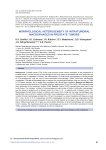
Morphological heterogeneity of intratumoral macrophages in prostate tumors
Статья научная
Background. Prostate cancer (PCa) is the most common human cancer worldwide. in the progression of prostate cancer, the total number of macrophages in the tumor tissue is associated with poor prognosis and increased risk of metastasis. However, the heterogeneity of intratumoral macrophages at various stages of PCa development, and the role of tumor-associated macrophages (TAMs) have been insufficiently investigated. The aim of the study was to analyze the morphological features, size and number of TAMs in PCa tissue samples, and to reveal their correlation with clinical data of patients. Material and Methods. immunohistochemical analysis of 36 paraffin blocks of patients with PCa (pT2a-3bN0-1M0) was performed using antibodies to the scavenger receptor CD68. Results. Foamy CD68+ macrophages were found in the tumor tissue. The indicator "number of macrophages per total number of fields of view with macrophages" was the lowest in patients with a Gleason score of 6 (5.8) (11.0 - in patients with a Gleason score > 8). Macrophages formed larger clusters in patients with severe PCa. Small but not large macrophages were significantly more common in patients with lymph node metastases (48 vs 24 in the N0 group; p=0.14). The number of small macrophages (smaller than 100 pm2) increased in a series of patients with Gleason scores of 6, 7 and > 8 (24, 47.5, 72, respectively, p=0.052). Conclusion. As the tumor process progressed and the risk of biochemical recurrence increased, there was a trend towards an increase in the total area of large, foamy TAMs, presumably rich in lipids, as well as wider distribution of small macrophages with a tendency to form clusters. We hypothesize that foamy macrophages are involved in the further recruitment of small TAMs, subsequently leading to metastasis and tumor progression.
Бесплатно
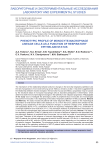
Статья научная
The mechanism of the relationship between pretumor changes in the bronchial respiratory epithelium and the risk of progression of non-small cell lung cancer (NSCLC) remains unclear. It has been suggested that the relationship between reactive changes in the bronchial mucosa and NSCLC progression may be caused by the functional status of monocytic-macrophage cells as important participants in inflammation, which determines both the risk of premalignant changes in the epithelium and malignant progression. The purpose of the study was to investigate the phenotypic profile of peripheral blood monocytes and macrophages induced from monocytes in vitro depending on the state of respiratory epithelium in NSCLC patients. Material and Methods. The study included 39 patients with newly diagnosed NSCLC. Based on the morphological examination of small bronchi taken at the distance of 3-5 cm from the tumor, patients were divided into the following groups depending on the type of pretumor changes: no pretumor changes (n=6), isolated basal cell hyperplasia (BCH) (n=13), combination of BCH and squamous metaplasia (SM) (n=3), combination of unchanged epithelium and focal BCH (n=17). The phenotypic features of peripheral blood monocytes and in vitro-induced macrophages were assessed before treatment using flow cytometry. Results. The state of the respiratory epithelium in NSCLC patients prior to the start of anticancer treatment was associated with the phenotypic features of peripheral blood monocytes, but not with the profile of macrophages induced from them. Distortion of the response of induced macrophages to the polarizing stimuli was observed in NSCLC patients: the cultured cells responded to both M1 and M2 inducers (LPS and IL-4, respectively) with a phenotype shift to M2, while the CD206 marker expression varied depending on the presence and type of pretumor changes. Conclusion. The phenotypic profile of peripheral blood monocytes was associated with the state of the respiratory epithelium in NSCLC patients before anti-tumor treatment, but not with the phenotypic features of induced macrophages.
Бесплатно
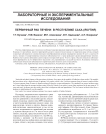
Primary liver cancer in the Republic of Sakha (Yakutia)
Статья научная
Territorial and ethnic features of the prevalence of primary liver cancer in the republic of Sakha have been studied. The republic has been shown to be a high-risk area for primary liver cancer, which is the 2-nd most common form of cancer in males and the 3-rd most common form of cancer in females among all digestive system malignancies. The standard liver cancer incidence rates are 5 times higher than the average incidence rates in Russia. Primary liver cancer is more oftern registered in the age group of 70 years and more. Incidence rates are mainly raised due to indigenous and rural populations. The liver cancer incidence rates show a tendency to stabilization all over the republic.
Бесплатно

